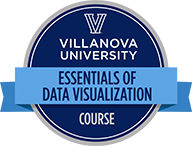Organizations have an increasing amount of data at hand, but interpreting that data to make informed business decisions is a crucial next step in data analysis.
Villanova’s online Essentials of Data Visualization course helps remove the clutter of complex information and allows you to build powerful at-a-glance dashboards that tell your data’s story and monitor the progress of your company goals at all levels: strategic, tactical and operational.
Combining Theory and Practice
Villanova’s Essentials of Data Visualization course combines theory and practice with a focus on real-life application. You’ll gain hands-on experience by building at-a-glance dashboards within two industry-leading data visualization tools, Tableau and Qlik. The dashboards you’ll create highlight trends, patterns, relationships and outliers through compelling dashboards, charts, graphs and diagrams.
The Villanova College of Professional Studies provides hands on access to Qlik and Tableau during the class.





